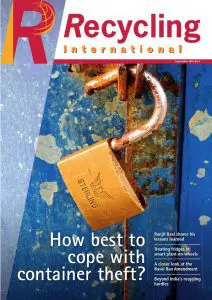Page 49 from: September 2014

49September 2014
M e t a l s i n i n d i a
Zain Nathani: there is ‘renewed
optimism’ that the new govern-
ment will focus on economic
growth and infrastructure pro-
jects.
Venkatesan Subramanian: the
establishment of a strategic
recycling zone or ‘scrap metal
city’ should be the long-term
vision.
has pushed up production costs for secondary
metal processing.
• The Indian government’s free trade agree-
ments with some countries of the Association
of Southeast Asian Nations (ASEAN) means
semi-finished and finished goods can be
imported into India with a 0% customs duty,
as a result of which imports of raw materials
have become costlier than finished products.
• Low labour productivity, high power costs
and insufficient power supply.
• High customs duties on scrap processing
equipment.
According to Subramanian, the government
has announced that it will lower the duty on
imported ships for shipbreaking from 5% to
2.5% – a move which would boost the domestic
steel industry given that it would reduce the
procurement cost of metal scrap.
Long-term vision
In tune with the words of Ikbal Nathani, Sub-
ramanian also called for the setting-up of spe-
cial subsidised recycling zones, the removal of
import duties and SADs on incoming scrap,
and carbon credits for the recycling industry.
‘We will have to create many organised scrap
collection yards across all industrial plants,
states, cities and towns which will trigger the
usage of scrap and thus drive the Indian econ-
omy,’ Subramanian insisted. He pointed to
preventing recyclables from contamination as
a major issue: the current model of recycling
through scavenging of refuse inherently low-
ered the quality and increased the cost of sepa-
ration for recycling companies.
The same speaker also pleaded for cluster devel-
opment through the establishment of a scrap
metal city, a recycling zone in a strategic location
close to end customers. ‘This should be the long-
term vision; necessary government subsidies
and tax holidays will be an added bonus,’ he said.
In addition, Subramanian told the audience
that they should utilise their scrap plants to the
maximum extent – in terms of both volume and
profit – to contribute to India’s GDP, and have
long-term plans to export recycled scrap.
The secondary aluminium market in India is expected to create ‘huge’
employment opportunities in the next 10 years.
Focus on aluminium
In 2013, India’s aluminium industries consumed more than 1 million tonnes of scrap, which was
typically used for aluminium casting by secondary alloy producers and for billet production.
Of this scrap, 724 000 tonnes was imported while around 300 000 tonnes was domestically gener-
ated. Imports originated mainly from the United Arab Emirates, Saudi Arabia, the UK, the USA, South
Africa, Germany, the Netherlands, Austria and Kuwait. Meanwhile, India exported some 6000 tonnes
of aluminium scrap last year.
In addressing the Metal Recycling Association of India’s latest gathering in Mumbai, Venkatesan
Subramanian of consulting and market analysis firm Frost & Sullivan noted that ‘aluminium is the
fastest-growing metal in India, currently growing more than India’s GDP’. He elaborated: ‘The develop-
ment and expansion of new aluminium smelters such as Hindalco and Vedanta will mean more second-
ary remelting opportunities for the recycling industry. The Indian aluminium market is a key contributor
to the recycling industry and will undoubtedly generate valuable metal scrap. Furthermore, the second-
ary aluminium market in India will create huge employment opportunities in the next 10 years.’
According to the speaker, there will be increased scope for using more aluminium scrap in remelting
activities for downstream players by procuring the right alloy grade, recycling and thereby saving costs
and energy while reducing the carbon footprint. He also forecast that aluminium would increasingly
replace traditional materials such as steel in the automotive sector. ‘The industry will have close link-
ages with the automotive industry for buy-back agreements coupled with supply of scrap,’ he stated.
‘This is directly linked with automotive OEM growth in India.’
Subramanian also observed that most Indian recycling companies operate with outdated technology,
leading to high levels of pollution and energy consumption. ‘This is an area that needs to be addressed
by the Indian aluminium industry,’ he said. ‘Modernisation of equipment is a key challenge and our
government should provide the industry with the necessary subsidies.’
‘We are all hopeful
that domestic steel
demand will rebound
later this year.’
RI-7 India metals.indd 49 28-08-14 15:01



